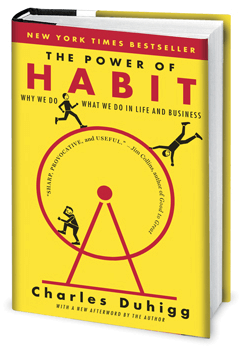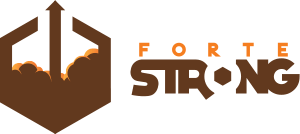What is a Healthy Habit?
 Thefreedictionary.com defines a healthy habit as, “A behavior that is beneficial to one’s physical or mental health, often linked to a high level of discipline and self-control.” According to Charles Duhigg, best-selling author of the book The Power of Habit and award-winning reporter at the New York Times explains that habits contain a three step loop consisting of a cue, a routine, and a reward. In fact, this cue, routine, reward loop (habits) shapes each and every day of our lives and we don’t even know it. Why? Because habits are gradual, instinctual and subconsciously under our radar, controlling our daily routines; when we eat, where we go, what we wear and how we behave. Habits are like breathing… we all know we do it, but how often are we aware of it?
Thefreedictionary.com defines a healthy habit as, “A behavior that is beneficial to one’s physical or mental health, often linked to a high level of discipline and self-control.” According to Charles Duhigg, best-selling author of the book The Power of Habit and award-winning reporter at the New York Times explains that habits contain a three step loop consisting of a cue, a routine, and a reward. In fact, this cue, routine, reward loop (habits) shapes each and every day of our lives and we don’t even know it. Why? Because habits are gradual, instinctual and subconsciously under our radar, controlling our daily routines; when we eat, where we go, what we wear and how we behave. Habits are like breathing… we all know we do it, but how often are we aware of it?
Why do habits affect my life?
Habits affect every part of our lives, but how can we identify them? Whether you are conscious of it or not, habits are beneficial to you in one form or another because, ultimately, they provide you with a specific outcome or a “reward”. Even negative habits provide a benefit, but at a cost. Many habits are formed as a way of coping with stress. People find stress relief in different ways, smoking, eating, exercising, etc. A stressor is what triggers people and as a result people engage in a behavior that rewards them with relief from that stress. In some cases the habit/behavior creates a full relief, whereas in others it is only temporary. A great example of a habit that gives only temporary relief is drugs. The drug user gets stressed (the cue), they use drugs (behavior/routine) and they get relief from stress for as long as the effects last (reward). Any habit becomes ingrained because of this unique cue, routine and reward cycle that is continually repeated. Because the drug use cycle leads to only temporary relief and does not address the underlying need in a healthy way, it would be classified as a bad habit.
How can I create healthy habits?
“To change ourselves effectively, we first had to change our perceptions.”
― Stephen R. Covey, The 7 Habits of Highly Effective People: Powerful Lessons in Personal Change
Before we go about creating healthy habits, we need to change our perception of how habits work. The golden rule of habit change is that “you cannot extinguish a bad habit, you can only change it” (Duhigg). Cues or triggers are going to happen and rewards stem from basic needs, so the only thing people have control over is what they do in response to the cues that come their way. What actually needs to change is not reward or the cue, but the routine. This can be a difficult thing because habits are learned behaviors that have been handed off to our subconscious mind where we don’t have to think about doing them because our subconscious is doing the routine for us. In other words, habits are just routines that are automatic.
 Let me give you a good example. A man, we will call him Pete, who gets home from work (cue), is seeking to relax (reward). Pete gains relaxation by eating Hot Pockets and an ice-cold Mountain Dew each night. Pete wants to change this habit because he’s gaining a lot of weight and not feeling good about himself. Pete decides he will go home and instead of eating to relax he will hold his baby to relax. With the occasional fast food pitfall here and there, eventually over time Pete sticks with this routine and soon holding his baby is what gives him relaxation (reward) as opposed to eating to get it. As you can see, the reward stayed the same but the routine is what changed. The habit itself has not been extinguished, it’s only been changed.
Let me give you a good example. A man, we will call him Pete, who gets home from work (cue), is seeking to relax (reward). Pete gains relaxation by eating Hot Pockets and an ice-cold Mountain Dew each night. Pete wants to change this habit because he’s gaining a lot of weight and not feeling good about himself. Pete decides he will go home and instead of eating to relax he will hold his baby to relax. With the occasional fast food pitfall here and there, eventually over time Pete sticks with this routine and soon holding his baby is what gives him relaxation (reward) as opposed to eating to get it. As you can see, the reward stayed the same but the routine is what changed. The habit itself has not been extinguished, it’s only been changed.
Steps you can take to change your habits!
Step 1: Identify the habit loop.
This is the biggest step. You can’t change what you don’t know.
Step 2: Create a plan to change the habit.
In this step, you will be creating a plan and replacing the routine you already have in place. It’s a good idea to write this plan down in order to look back on it often. In important point is to keep the plan simple. If it’s too complicated, it will be to hard to follow.
Step 3: Implement the plan.
This step will take the longest time. You are trying to change something that you do automatically without thinking. Expect to make some mistakes. Look back on your plan and keep working at it. You will need to maintain it and implement the plan time and time again until the new routine takes over the old routine and you have formed a new habit.
Step 4: Repeat
Using these steps is best when working on one habit at a time. You can’t expect to fix every habit all at once. Take the time to work on one then repeat the process to work on the next.
So, if you want to address a bad habit, don’t stop it, change it by following the 4 steps!
Resources
Covey, S. The 7 Habits of Highly Effective People: Powerful Lessons in Personal Change. Simon & Schuster, NY, 1989.
Duhigg, C. The Power of Habit. Random House, LLC, NY. 2012
Healthy Habit. Thefreedictionary.com. Available at:http://http://medical-dictionary.thefreedictionary.com/healthy+habit.
About The Author
Brook Price dedicated himself to helping others early in his life. He grew up in Sunny Orange County California, then joined the Marine Corps at the age of 21 serving five and half years as a helicopter crew chief and then as chief accountant. His journey with this type of work began when he volunteered as a Young Marines Instructor during his time in the Marines, helping kids get off the street, improve their lives and develop as a leader. After his tour Brook left the Marines to pursue a career in experiential therapy by attending Southern Utah University where he majored in outdoor recreation with a minor in psychology.
Brook has seventeen years experience working for a variety of different therapeutic and transitional programs across the nation. His thirst for knowledge drove him to learn and study successful therapeutic models and programs across the country, most notably Outward Bound. Brook has experience working with therapeutic, residential, military, wilderness and transitional programs for adults and adolescents.

